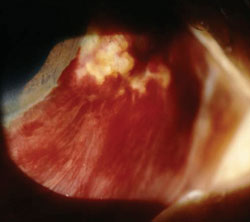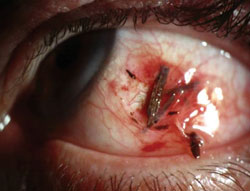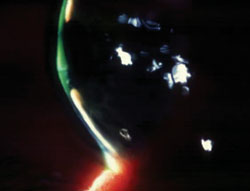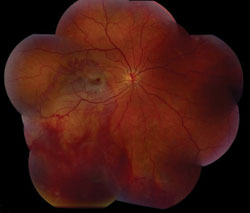Carefully examine patients with trauma-induced retinal hemorrhage
Trauma-induced retinal hemorrhages are rare, but if a patient comes in with one be sure to conduct a comprehensive examination. Experts agree that possible damage to the globe and retina have more serious repercussions than the hemorrhage itself.
 |
Take a thorough history
When Mark T. Dunbar, OD, FAAO, first meets with a patient who has trauma-induced retinal hemorrhage, he takes a detailed history before beginning the examination.
“I like to learn all about the trauma: when it occurred, what type of trauma it is and how it occurred. I also want to carefully inspect the external part of the eye, especially the lids and conjunctiva,” Dr. Dunbar said in an interview with Primary Care Optometry News.
Trauma that causes hemorrhage
Many different types of ocular trauma can cause retinal hemorrhage, PCON Editorial Board member Michael J. Tolentino, MD, said in an interview. Among them are Valsalva’s retinopathy, choroidal rupture and commotion retinae, which results from serious blunt trauma.
 Penetrating injury, open globe: An eye with low pressure may indicate an open globe. Images: Dunbar MT |
“With Valsalva’s retinopathy, if a patient vomits or coughs forcefully, it can cause bleeding inside the eye,” he said. “Sometimes the bleeding is quite extensive and it evolves into something more like a vitreous hemorrhage.
“Other kinds of retinal hemorrhages may result from extensive trauma such as a baseball injury to the eye,” Dr. Tolentino continued, “and patients can get a condition called commotion retinae. There is a disruption of the photoreceptors in commotion retinae, and the patient could have permanent vision loss from that kind of trauma.”
Steven Ferrucci, OD, FAAO, cautions that patients who experience severe blunt trauma might also go on to develop secondary glaucoma as a result.
  Ruptured globe. |
|
“A lot of those patients, probably around 50% or so, have some angle recession associated with severe blunt trauma,” he told PCON. “So you want to do gonioscopy and look at their angle. Patients can develop secondary glaucoma up to 25 years after the original injury. Another thing to consider is if you see a traumatic retinal hemorrhage in a child, suspect child abuse until proven otherwise.”
Conducting an examination
When examining a patient with retinal hemorrhage in the setting of trauma, Dr. Dunbar said that the most important goal is to ensure the patient does not have an open globe or a penetrating injury.
“I try to make sure that I can visualize the globe and see if there was any type of entrance wound,” Dr. Dunbar said. “I measure the intraocular pressure and make sure it’s normal, because an eye with very low pressure might indicate that the patient has an open globe. I also check for a vitreous hemorrhage in addition to the retinal hemorrhage, if the retina is attached or detached and if I can see any intraocular foreign body. These are all things you want to rule out through the course of your work-up.”
 This patient had counting fingers vision at 1 foot. No peripheral pathology was seen on the dilated fundus exam. Ultrasound showed no tear or retinal detachment peripherally. |
Though traumatic retinal hemorrhages are a concern, Dr. Ferrucci said, the trauma that caused the hemorrhage might have damaged other parts of the eye as well.
“Make sure you do a good retinal examination; look in the peripheral retina for any signs of retinal holes, tears or breaks, because those are actually more common than a traumatic retinal hemorrhage,” Dr. Ferrucci said. “You also want to educate patients about the signs and symptoms of a retinal detachment so they know to look out for those as well.”
Avoid jolting activities, aspirin
Dr. Tolentino advises patients to refrain from jolting activities that could disrupt the surface of the vitreoretinal interface, specifically theme park rides and high-intensity aerobics.
“I tell patients not to do anything that’s going to accelerate or decelerate their eyes,” he said. “No roller coasters, bumpy car rides or jostling activities. These could disrupt the surface of the vitreoretinal interface. If the trauma was significant enough to cause hemorrhage, then it was definitely strong enough to cause a disturbance in this vitreoretinal interface. I tell my patients to avoid further traumatic activities that could potentially produce or encourage a retinal tear or retinal detachment.”
Another concern is the effect aspirin or other blood-thinning medications might have on the bleeding in the eye.
“I have patients avoid aspirin that’s not for stroke prevention until the hemorrhage resolves,” Dr. Ferrucci said. “Unnecessary aspirin may affect the bleeding.”
Re-examine suspicious cases
Unless there are visual symptoms associated with the hemorrhage, Dr. Dunbar will bring the patient back into the office within a few weeks, he said.
“How often I see the patient depends on the severity and extent of the hemorrhage,” he said. “For an isolated and incidental hemorrhage, it may be a couple of weeks. If I’m suspicious there might be an open globe, I’ll bring them back within a week, or maybe within a few days.”
For more information:
- Mark T. Dunbar, OD, FAAO, can be reached at Bascom Palmer Eye Institute, University of Miami, Miller School of Medicine, 900 NW 17th St., Miami, FL 33136; (800) 329-7000, ext. 4042; fax: (305) 326-6585; e-mail: mdunbar@med.miami.edu.
- Steven Ferrucci, OD, FAAO, is chief of optometry at the Veterans Affairs Sepulveda Ambulatory Care Center in Sepulveda, Calif., and an associate professor at the Southern California College of Optometry. He is also a fellow of the Optometric Retina Society. He can be reached at Sepulveda VA Ambulatory Care Center, 16111 Plummer St. #112E, Sepulveda, CA 91343: (818) 891-7711, x7744; fax: (818) 895-9597; e-mail: steven.ferrucci@va.gov.
- Michael J. Tolentino, MD, a member of the Primary Care Optometry News Editorial Board, can be reached at 250 Avenue K, SW, Winter Haven, FL 33880; (863) 297-5400; fax: (863) 293-9780; e-mail: miket@crmd.net. Web site: www.crmd.net.
